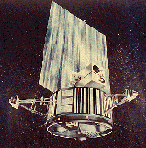|
|

OSO-8
The 8th Orbiting Solar Observatory (OSO-8) was launched on 21 June 1975.
Its lifetime overlapped with Ariel 5 (1974-1980), HEAO1 (1977-1979), and SAS-3
(1975-1979).
It was placed into a 550 km circular orbit with a 33 degree inclination to the
Earth's equator and was operated in both scanning and pointing mode. The
satellite spin period was 10.7 seconds. The structure of OSO-8 consisted of
a rotating cylindrical base section called the "wheel" and a non-spinning
upper section called the "sail". While the objectives of the mission were
solar in nature, four experiments were mounted in the rotating wheel to
exclusively observe cosmic X-ray sources. The first three experiments had
their fields-of-view either aligned to the spin axis of the spacecraft or at
small angles to it. Hence they always viewed the portion of the sky at right
angles to the earth-sun line. The fourth instrument observed cosmic X-ray
sources during the satellite night. The objectives of the four X-ray
experiments was to observed the X-ray background, study intensity and
spectral variations of cosmic X-ray sources, and to measure the degree of
polarization of the X-rays observed from these sources.
The Cosmic X-ray Spectrometer was a Goddard Space Flight Center effort headed
by P. J. Serlemitsos. The experiment consisted of two xenon (detectors A and
C) and one argon (detector B) proportional counters. Two of the counters (B
and C) had their fields of view oppositely aligned to each other and coaligned
to the spin axis with the B detector located at the negative spin axis. The
third counter (A) was aligned with a 5 degree offset to the aft spin axis so
that with each wheel revolution it scanned the region of the sky within 10
degrees of the aft axis direction. The two aft pointed counters had
clear fields of view while the forward pointed counter had its field of view
periodically occulted by the pointed instruments under the spacecraft sail.
A 64 channel spectrum was obtained every 40.96 second for the B and C
detectors and every 2.56 seconds for the scanning A detector. Integral rates
were also available from all the detectors with 160 millisecond resolution.
The High-Energy Celestial X-ray Experiment, a Goddard Space Flight Center
effort headed by K. H. Frost, measured the spectrum of X-ray sources in the
energy range of 0.01 - 1 MeV and searched for temporal variations in the
intensity and spectrum of point sources. In addition, it measured the diffuse
component of celestial X-rays over a scanned strip of the sky and set limits
on the intensity and isotropy of the 0.511 MeV positron annihilation
radiation.
The Soft X-ray Background Radiation experiment of W. L. Kraushaar (U.
Wisconsin) studied the galactic latitude dependence of the X-ray background
radiation using proportional counters with as narrow a collimation as
practical in the region 0.150 - 45 keV. Energy resolution relied largely on
selective window transmission rather than pulse height measurement. Viewing
was parallel and anti-parallel to the wheel spin direction, so that two
single paths across the sky, galactic pole to galactic pole, were carefully
surveyed with high statistical accuracy approximately every 6 months.
The Graphite Crystal X-ray Spectrometer, a Columbia University experiment
headed by H. L. Kestenbaum, was used to measure continuum profiles over the
2 - 8 keV band with high spectral resolution. During satellite day, solar
spectra were obtained. Stellar X-ray sources were observed during satellite
night. The spectrometer made use of the wheel rotation to obtain a complete
Bragg spectrum every 10 seconds. X-rays transmitted by the slat collimators
struck the large graphite crystal panels. Those X-rays which satisfied the
Bragg condition for reflection from graphite were reflected into the central
bank of detectors. The detectors were double-sided proportional counters with
0.025 mm beryllium windows on each side and contained an argon-xenon gas
mixture chosen for its high efficiency over the 2 - 8 keV range. The Graphite
Crystal X-ray polarimeter experiment, also out of Columbia University,
operated in a similar fashion reflecting X-rays off of a graphite crystal
panel into a small proportional counter. The panels reflected preferentially
those X-rays polarized perpendicular to the plane defined by the incident and
reflected rays.
[OSO-8 Home]
[About OSO-8]
[Archive]
[Software]
[Gallery]
[Publications]
Page authors: Lorella Angelini Jesse Allen
HEASARC Home |
Observatories |
Archive |
Calibration |
Software |
Tools |
Students/Teachers/Public
Last modified: Wednesday, 08-Oct-2003 18:57:19 EDT
|


